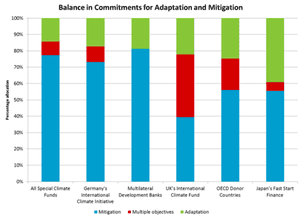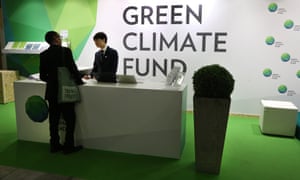Extract from The Guardian
Rich countries say they are on track to beating
the $100bn climate fund target, but poorer countries criticise the
unfair burden of loans and a stark lack of money for adaptation
The problem of the $100bn is not whether it will
be reached – it almost certainly will – but how. Photograph:
Patrick Aventurier/Getty Images
Friday 4 December 2015 23.55 AEDT
Poor countries at climate talks in Paris have
railed against an attempt to water down assistance promised to help
them overcome the climate crisis they did not cause.
Rich countries are committed to provide $100bn
(£66bn) to developing countries by 2020. More than any other, this
figure will decide the fate of the talks billed to stop climate
change.
On Wednesday, US special envoy for climate change
Todd Stern had told a press conference that donor countries were
“well
on the way to beating that pledge”.
Stern said a “conservative”
report compiled by the Organisation for Economic Co-operation and
Development (OECD), a thinktank sponsored by the richest countries on
Earth, in October “showed on the basis of 2014 numbers we are
around $62bn, probably a little bit more than that”.
For the period between now and 2020, he said:
“There have since that time been a number of pledges made both by
individual countries... I think if you look at all of those pledges,
plus what the OECD
have already totalled up... we are at a pretty high number, both
where we are now and where we’ll be over the next few years.”
And yet the problem of the $100bn is not whether
it will be reached – it almost certainly will – but how. There is
an
almighty gap between how the developing and developed worlds
define what counts as adequate climate assistance.
Within the monies the OECD counted as climate
finance was a vast range of loans, grants and aid relabelled as
climate-related, much of which developing countries do not see as
assistance but investment. On top of this, the OECD model adds in the
private capital “mobilised” by the trickle of public cash.
For example, Germany and France have promised to
increase their 2020 finance to $4.47bn and $4bn respectively. Yet
despite the similar numbers, grant-making Germany is seen as a leader
and money-lending France a villain.
For developing countries, loans are a particularly
problematic aspect of this methodology. Gambia’s environment
minister, and representative of the least developed countries group,
Pa Ousman Jarju said: “We cannot take loans to pay for climate
change and take that as climate finance. For us it needs to be
grant-based finance because we are not responsible for what is
happening.”
Stern’s upbeat analysis was scorned by Nozipho
Mxakato-Diseko, the South African chair of the Group
of 77 and China, who speaks for the poorest 134 countries in the
negotiations. She called the OECD report a “mirage” that was
being used to create the illusion of a finance process on the right
track.
“We had been asking for work to be done by the
[UN] standing
committee on finance. An institution of the convention. And every
time we asked, those requests were refused,” said Mxakato-Diseko.
Instead, she said, wealthy countries had elevated
the methodology of a thinktank to de facto UN climate policy, without
consultation.
“We woke up to find that we had a report that
was telling us that we were accomplishing [$100bn]. We were not aware
of that report. We were not aware that countries had mandated that
report,” she said.
Oxfam’s climate policy adviser Jan Kowalzig
said: “It’s deeply concerning that a donor-driven methodology
like that of the OECD is being used to champion rich country climate
funding [as being] at a pivotal stage in sealing a climate deal. The
system is far from perfect and, critically, is based on donor
countries’ choices on what and how to count, allowing funding
levels to look higher than they actually are.”
There is just one day of talks left before
negotiators must hand over a workable draft to their various
ministers for the second phase of deal-making. For the US, using the
OECD methodology puts the talismanic $100bn within reach, defusing an
issue insiders say has become utterly intransigent.
A second tortured sore is the balance between
funding for “adaptation” – coping with the effects of climate
change – and “mitigation”, carbon cutting interventions.
Mitigation tends to attract vastly more finance because its profile –
renewable energy, forestry, agriculture - comes with readymade
business models and can convince private capital to provide
additional help. Because of this, mitigation attracts roughly three
quarters of all climate finance.

Adaptation and mitigation in climate finance
Photograph: WRI
Adaptation, much of which involves improving
infrastructure, offers no such ready profit model and generally
requires grants. The African negotiating bloc has called for
adaptation finance to reach $32bn a year by 2020. But Kowalzig said
that even with new pledges, public adaptation money was only likely
to amount to $5-8bn per year in 2020.
“If today’s public adaptation finance were
divided among the world’s 1.5 billion smallholder farmers in
developing countries, they would get around $3 each year to cope with
climate change – the price of a cup of coffee in many rich
countries,” he said.

No comments:
Post a Comment